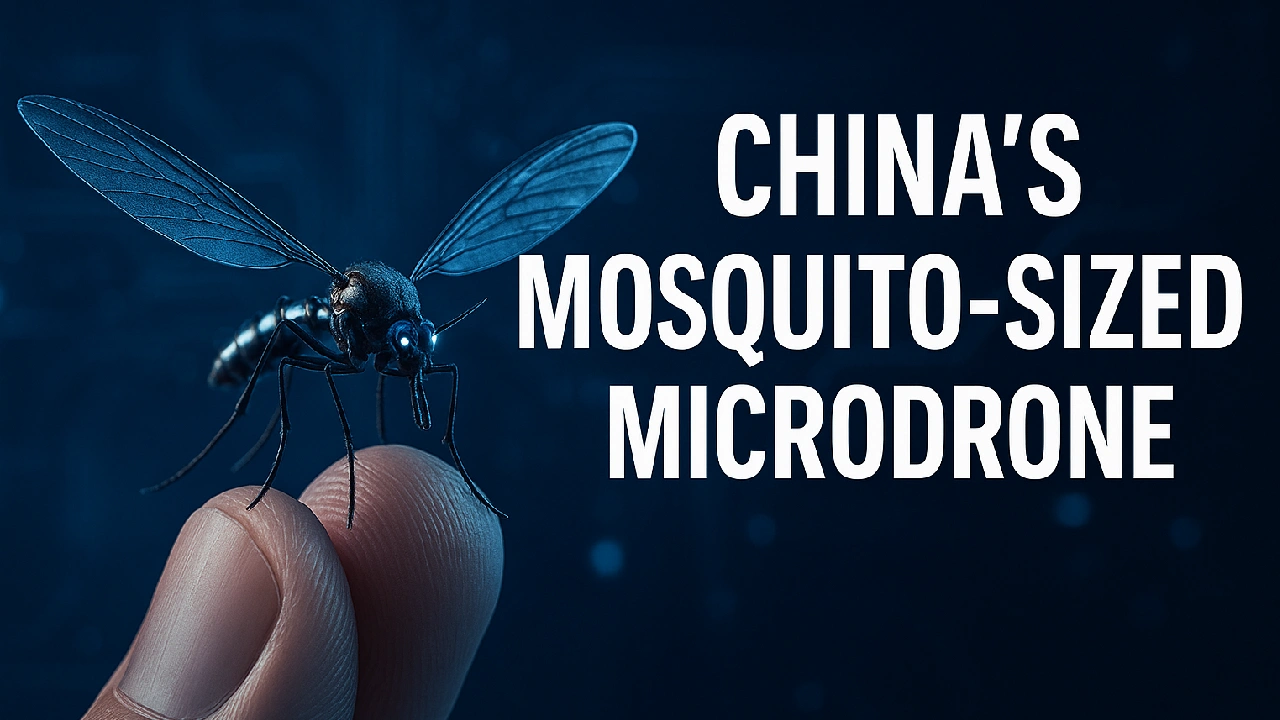Introduction
Mosquito-sized drones in a stunning display of military innovation, China has officially unveiled a new class of ultra-small unmanned aerial vehicles (UAVs), commonly referred to as mosquito-sized drones. First introduced in early 2025 through a Chinese state television broadcast (CCTV-7), these insect-like drones are designed for battlefield intelligence, surveillance, and reconnaissance. The development, led by the National University of Defense Technology (NUDT), underscores China’s growing focus on micro and autonomous warfare technologies. With dimensions comparable to a real mosquito and flapping-wing flight mechanisms, these drones represent a significant leap in stealth surveillance capabilities.

Google AI Features 2025 – Groundbreaking New AI Innovations Transforming Daily Life and Work
What Are Mosquito-Sized Drones?
Mosquito-sized drones are micro UAVs (unmanned aerial vehicles) that replicate the size and motion of flying insects. Designed to be inconspicuous, these drones are about 1 cm long and weigh under 0.3 grams. Their small size allows them to navigate tight spaces and avoid detection by both the naked eye and radar systems. They are built using lightweight composite materials and advanced MEMS (micro-electro-mechanical systems) that enable silent propulsion and agile movement mosquito-sized drones.
Purpose and Strategic Significance
The primary objective of these drones is to carry out covert surveillance and intelligence-gathering missions in battlefield and high-security environments mosquito-sized drones. They are intended to:
- Enhance tactical reconnaissance in real-time
- Assist with urban warfare operations where larger drones cannot reach
- Monitor chemical, biological, or radiological hazards
- Act as an invisible tool for espionage and signal interception
According to defense experts, these drones are part of China’s broader military strategy focusing on swarm technology and unmanned systems, designed to give the People’s Liberation Army (PLA) a significant edge in modern combat mosquito-sized drones.
Key Features & Capabilities
- Flapping Wing Technology: Mimics the natural flight of mosquitoes or flies, allowing them to hover and maneuver precisely.
- Miniature Sensors & Cameras: Embedded micro-cameras and possibly directional microphones for discreet surveillance.
- Hair-Thin Legs: Allow the drone to land silently on walls, ceilings, or foliage without detection.
- Silent Electric Propulsion: Makes these drones nearly inaudible, making them ideal for espionage and stealth missions.
- Navigation Systems: Likely to use infrared or micro-GPS modules for autonomous movement in GPS-denied environments.
When Were They Launched?
These mosquito-sized drones were first publicly showcased in early 2025 via China’s military media. However, experts speculate that the research and prototype testing may have been ongoing since at least 2022. The project is reportedly under the wing of China’s dual-use technology initiative, integrating military and civilian R&D to boost innovation.
Possible Uses on the Battlefield
- Covert Surveillance: Monitoring troop movement and enemy behavior without revealing presence.
- Eavesdropping: Capturing conversations or signals in restricted or sensitive zones.
- Indoor Reconnaissance: Ideal for maneuvering inside buildings, bunkers, or tunnels.
- Hazard Detection: Equipped with micro-sensors to detect harmful gases or radiation in combat environments.
- Swarm Deployment: Can be used in large numbers to confuse enemy radar or gather data collectively.
Limitations
- Short Battery Life: Due to their miniature size, they can only remain airborne for a limited time.
- Weather Vulnerability: Not suited for high wind or rain, which can easily knock them off course.
- Limited Communication Range: Micro radios have a shorter range, potentially requiring repeaters or relay drones.
Global Comparison
- USA: The U.S. has developed the Black Hornet Nano, already deployed by special forces. It offers real-time video and infrared imaging.
- Norway: Norwegian companies pioneered nano UAVs used by NATO forces for tactical surveillance.
- China’s Edge: China’s mosquito drones stand out due to their smaller size, flapping-wing mimicry, and stealthier build, possibly offering a tactical advantage in close-quarters intelligence gathering.
Ethical and Security Concerns
- Privacy Invasion: These drones could be misused for unauthorized surveillance, including on civilians.
- Espionage Risks: Their near-invisible presence raises concerns over state-sponsored spying.
- International Law Gaps: There are currently no clearly defined global regulations governing the use of such micro-drones in warfare.
Future Outlook
China’s mosquito drones are just the beginning. Future versions are expected to feature:
- AI integration for autonomous decision-making
- Extended battery life through nano-power innovations
- Enhanced swarm coordination for multi-drone tactical deployment
- Expanded sensory tools like heat detection or facial recognition in micro-scale
China is also working on drone “motherships” that can deploy micro-drones mid-air for swarm attacks or broad surveillance coverage.
Conclusion
The introduction of mosquito-sized drones by China marks a new chapter in the evolution of modern warfare. These drones are a clear demonstration of how small-scale robotics and military AI are shaping the future of defense strategies. As more nations enter the nano-drone race, the global battlefield is set to transform—favoring intelligence, precision, and automation over brute force.